Semester 1 2019: Evolutionary Perspectives on Health MMS3101
VerifiedAdded on 2023/04/19
|13
|3440
|256
Homework Assignment
AI Summary
This assignment provides answers to questions related to evolutionary perspectives on health and disease, covering topics such as coefficient of relationship, principles of natural selection, kin selection, human behavioral ecology, sexual selection, female ornamentation, Dunbar's social brain hypothesis, and the evolution of infectious diseases. It also discusses major disease outbreaks reported by the WHO and the impact of superbugs. The assignment includes specific examples and research findings to support the answers, offering a comprehensive overview of the evolutionary factors influencing health and disease.
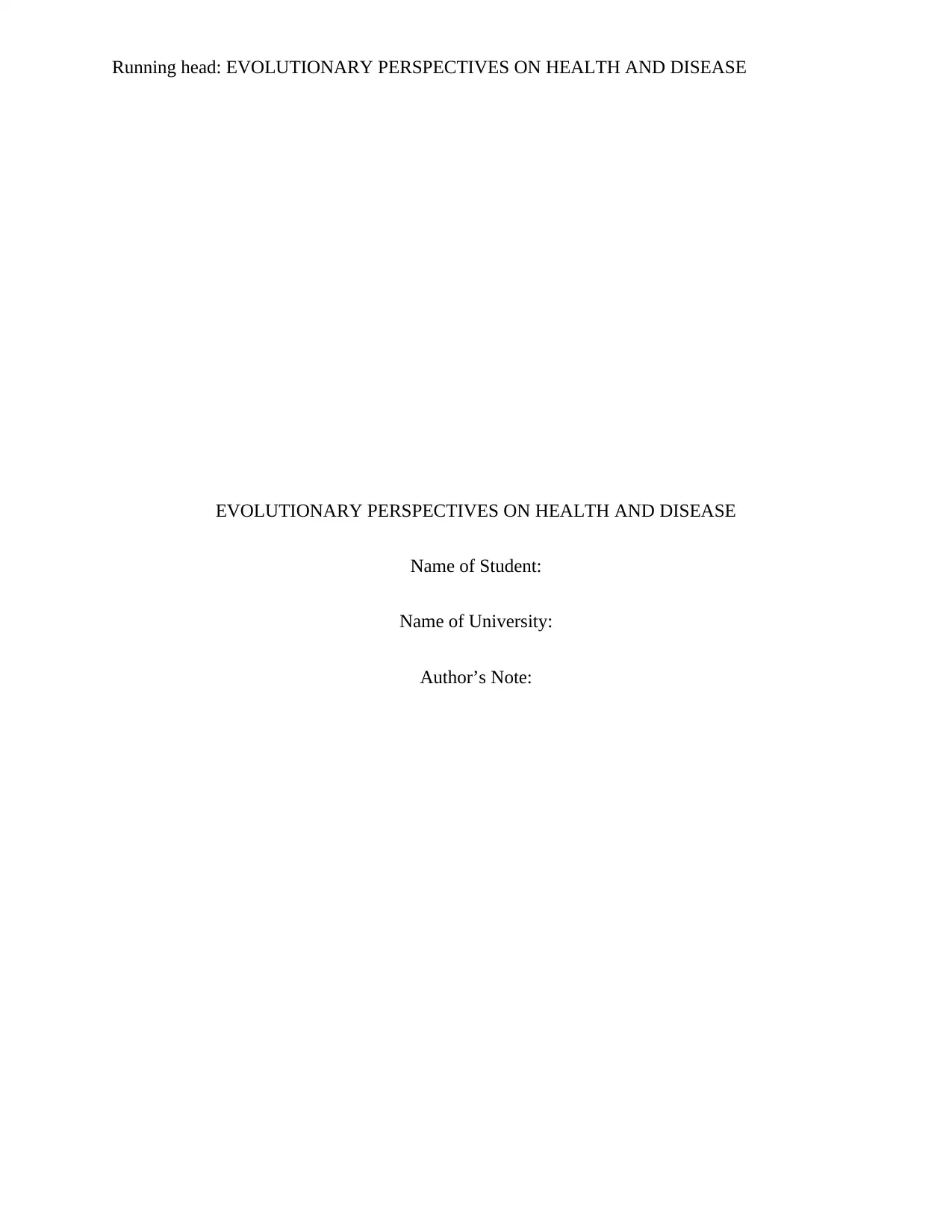
Running head: EVOLUTIONARY PERSPECTIVES ON HEALTH AND DISEASE
EVOLUTIONARY PERSPECTIVES ON HEALTH AND DISEASE
Name of Student:
Name of University:
Author’s Note:
EVOLUTIONARY PERSPECTIVES ON HEALTH AND DISEASE
Name of Student:
Name of University:
Author’s Note:
Paraphrase This Document
Need a fresh take? Get an instant paraphrase of this document with our AI Paraphraser
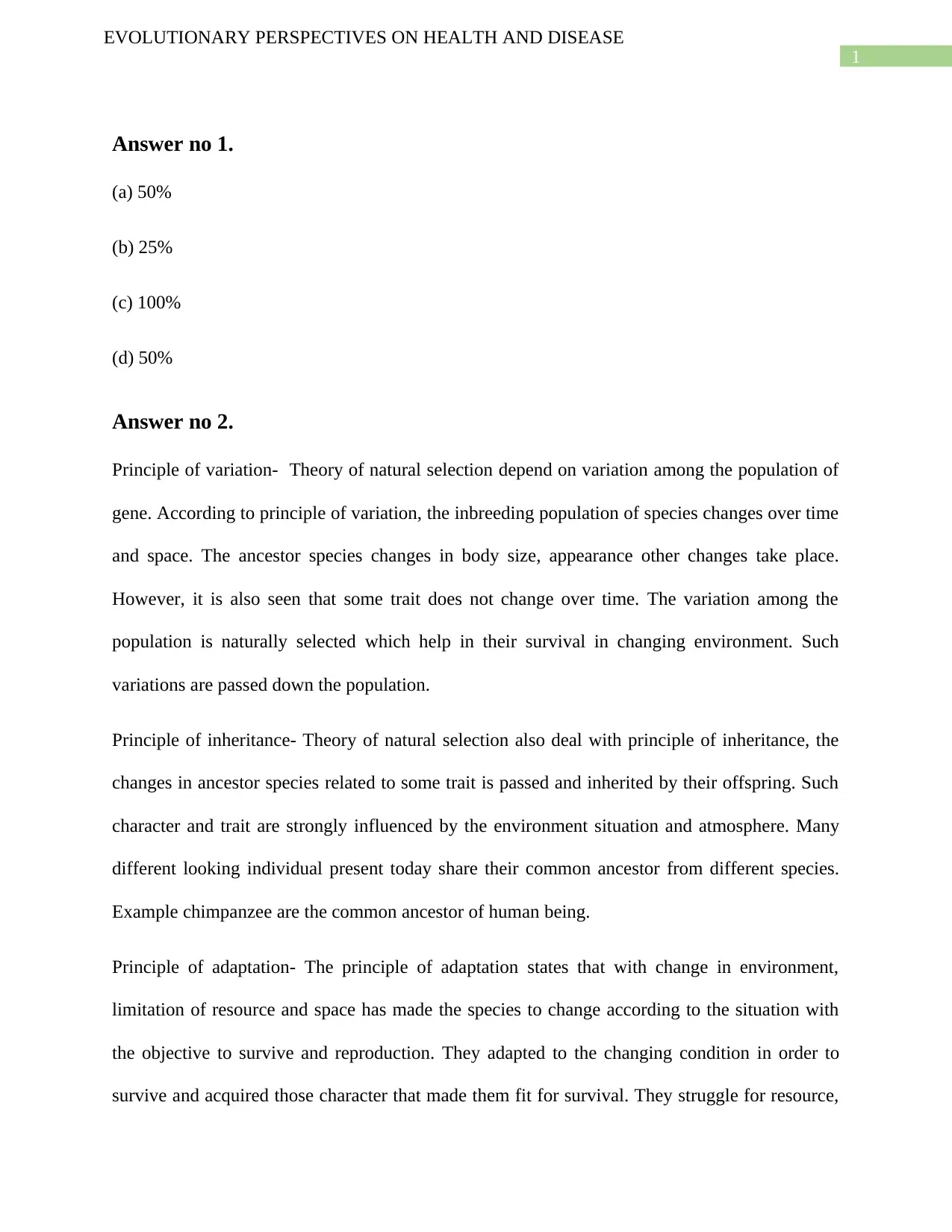
1
EVOLUTIONARY PERSPECTIVES ON HEALTH AND DISEASE
Answer no 1.
(a) 50%
(b) 25%
(c) 100%
(d) 50%
Answer no 2.
Principle of variation- Theory of natural selection depend on variation among the population of
gene. According to principle of variation, the inbreeding population of species changes over time
and space. The ancestor species changes in body size, appearance other changes take place.
However, it is also seen that some trait does not change over time. The variation among the
population is naturally selected which help in their survival in changing environment. Such
variations are passed down the population.
Principle of inheritance- Theory of natural selection also deal with principle of inheritance, the
changes in ancestor species related to some trait is passed and inherited by their offspring. Such
character and trait are strongly influenced by the environment situation and atmosphere. Many
different looking individual present today share their common ancestor from different species.
Example chimpanzee are the common ancestor of human being.
Principle of adaptation- The principle of adaptation states that with change in environment,
limitation of resource and space has made the species to change according to the situation with
the objective to survive and reproduction. They adapted to the changing condition in order to
survive and acquired those character that made them fit for survival. They struggle for resource,
EVOLUTIONARY PERSPECTIVES ON HEALTH AND DISEASE
Answer no 1.
(a) 50%
(b) 25%
(c) 100%
(d) 50%
Answer no 2.
Principle of variation- Theory of natural selection depend on variation among the population of
gene. According to principle of variation, the inbreeding population of species changes over time
and space. The ancestor species changes in body size, appearance other changes take place.
However, it is also seen that some trait does not change over time. The variation among the
population is naturally selected which help in their survival in changing environment. Such
variations are passed down the population.
Principle of inheritance- Theory of natural selection also deal with principle of inheritance, the
changes in ancestor species related to some trait is passed and inherited by their offspring. Such
character and trait are strongly influenced by the environment situation and atmosphere. Many
different looking individual present today share their common ancestor from different species.
Example chimpanzee are the common ancestor of human being.
Principle of adaptation- The principle of adaptation states that with change in environment,
limitation of resource and space has made the species to change according to the situation with
the objective to survive and reproduction. They adapted to the changing condition in order to
survive and acquired those character that made them fit for survival. They struggle for resource,
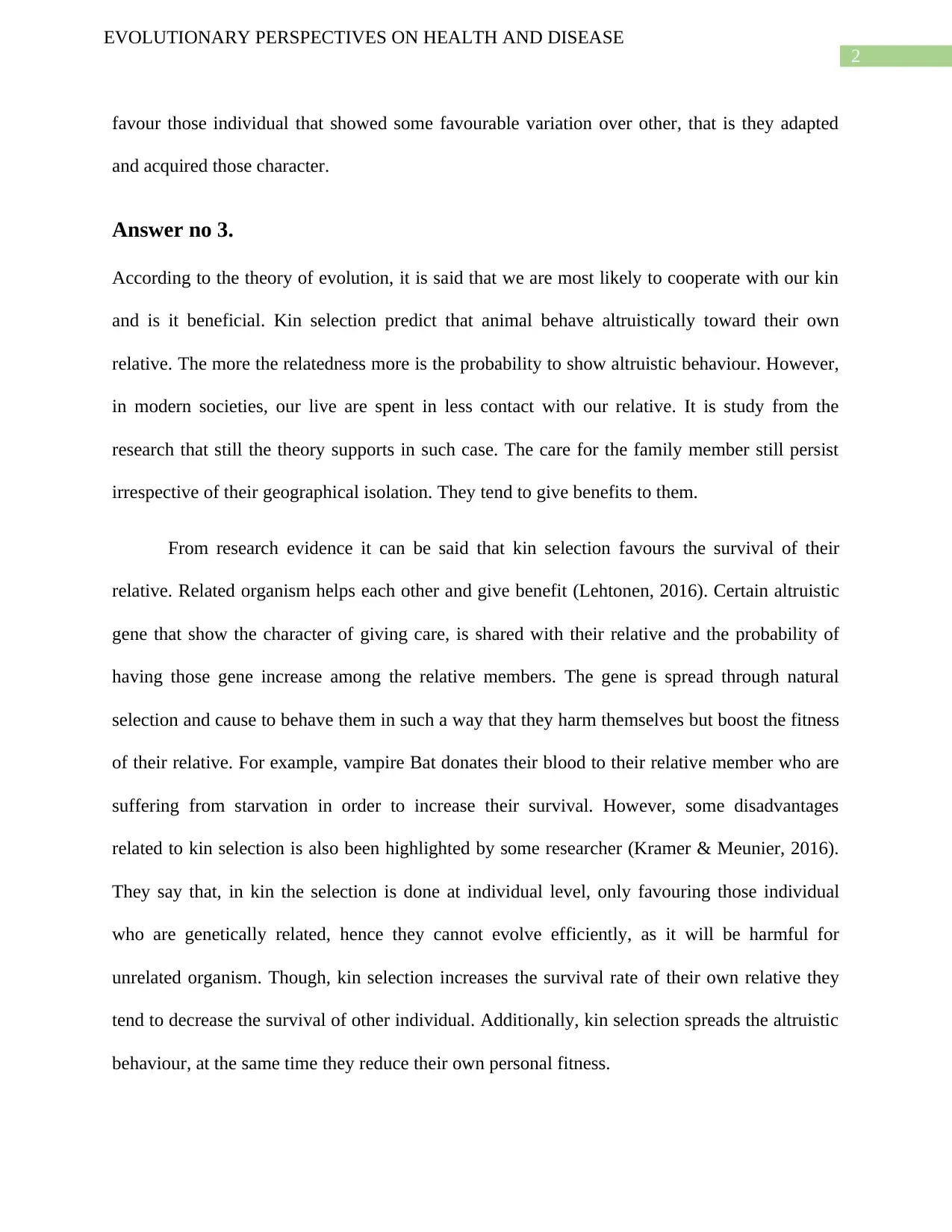
2
EVOLUTIONARY PERSPECTIVES ON HEALTH AND DISEASE
favour those individual that showed some favourable variation over other, that is they adapted
and acquired those character.
Answer no 3.
According to the theory of evolution, it is said that we are most likely to cooperate with our kin
and is it beneficial. Kin selection predict that animal behave altruistically toward their own
relative. The more the relatedness more is the probability to show altruistic behaviour. However,
in modern societies, our live are spent in less contact with our relative. It is study from the
research that still the theory supports in such case. The care for the family member still persist
irrespective of their geographical isolation. They tend to give benefits to them.
From research evidence it can be said that kin selection favours the survival of their
relative. Related organism helps each other and give benefit (Lehtonen, 2016). Certain altruistic
gene that show the character of giving care, is shared with their relative and the probability of
having those gene increase among the relative members. The gene is spread through natural
selection and cause to behave them in such a way that they harm themselves but boost the fitness
of their relative. For example, vampire Bat donates their blood to their relative member who are
suffering from starvation in order to increase their survival. However, some disadvantages
related to kin selection is also been highlighted by some researcher (Kramer & Meunier, 2016).
They say that, in kin the selection is done at individual level, only favouring those individual
who are genetically related, hence they cannot evolve efficiently, as it will be harmful for
unrelated organism. Though, kin selection increases the survival rate of their own relative they
tend to decrease the survival of other individual. Additionally, kin selection spreads the altruistic
behaviour, at the same time they reduce their own personal fitness.
EVOLUTIONARY PERSPECTIVES ON HEALTH AND DISEASE
favour those individual that showed some favourable variation over other, that is they adapted
and acquired those character.
Answer no 3.
According to the theory of evolution, it is said that we are most likely to cooperate with our kin
and is it beneficial. Kin selection predict that animal behave altruistically toward their own
relative. The more the relatedness more is the probability to show altruistic behaviour. However,
in modern societies, our live are spent in less contact with our relative. It is study from the
research that still the theory supports in such case. The care for the family member still persist
irrespective of their geographical isolation. They tend to give benefits to them.
From research evidence it can be said that kin selection favours the survival of their
relative. Related organism helps each other and give benefit (Lehtonen, 2016). Certain altruistic
gene that show the character of giving care, is shared with their relative and the probability of
having those gene increase among the relative members. The gene is spread through natural
selection and cause to behave them in such a way that they harm themselves but boost the fitness
of their relative. For example, vampire Bat donates their blood to their relative member who are
suffering from starvation in order to increase their survival. However, some disadvantages
related to kin selection is also been highlighted by some researcher (Kramer & Meunier, 2016).
They say that, in kin the selection is done at individual level, only favouring those individual
who are genetically related, hence they cannot evolve efficiently, as it will be harmful for
unrelated organism. Though, kin selection increases the survival rate of their own relative they
tend to decrease the survival of other individual. Additionally, kin selection spreads the altruistic
behaviour, at the same time they reduce their own personal fitness.
⊘ This is a preview!⊘
Do you want full access?
Subscribe today to unlock all pages.

Trusted by 1+ million students worldwide
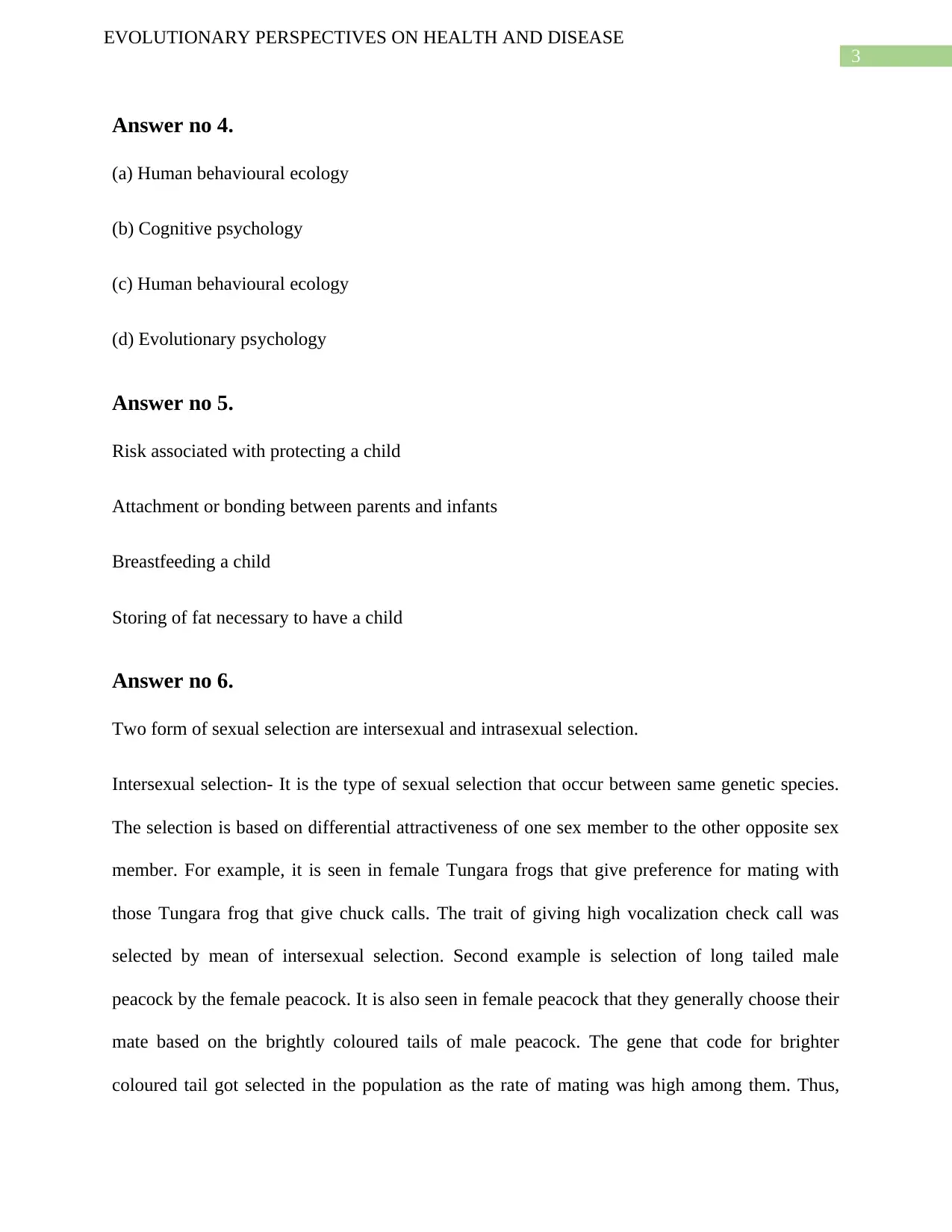
3
EVOLUTIONARY PERSPECTIVES ON HEALTH AND DISEASE
Answer no 4.
(a) Human behavioural ecology
(b) Cognitive psychology
(c) Human behavioural ecology
(d) Evolutionary psychology
Answer no 5.
Risk associated with protecting a child
Attachment or bonding between parents and infants
Breastfeeding a child
Storing of fat necessary to have a child
Answer no 6.
Two form of sexual selection are intersexual and intrasexual selection.
Intersexual selection- It is the type of sexual selection that occur between same genetic species.
The selection is based on differential attractiveness of one sex member to the other opposite sex
member. For example, it is seen in female Tungara frogs that give preference for mating with
those Tungara frog that give chuck calls. The trait of giving high vocalization check call was
selected by mean of intersexual selection. Second example is selection of long tailed male
peacock by the female peacock. It is also seen in female peacock that they generally choose their
mate based on the brightly coloured tails of male peacock. The gene that code for brighter
coloured tail got selected in the population as the rate of mating was high among them. Thus,
EVOLUTIONARY PERSPECTIVES ON HEALTH AND DISEASE
Answer no 4.
(a) Human behavioural ecology
(b) Cognitive psychology
(c) Human behavioural ecology
(d) Evolutionary psychology
Answer no 5.
Risk associated with protecting a child
Attachment or bonding between parents and infants
Breastfeeding a child
Storing of fat necessary to have a child
Answer no 6.
Two form of sexual selection are intersexual and intrasexual selection.
Intersexual selection- It is the type of sexual selection that occur between same genetic species.
The selection is based on differential attractiveness of one sex member to the other opposite sex
member. For example, it is seen in female Tungara frogs that give preference for mating with
those Tungara frog that give chuck calls. The trait of giving high vocalization check call was
selected by mean of intersexual selection. Second example is selection of long tailed male
peacock by the female peacock. It is also seen in female peacock that they generally choose their
mate based on the brightly coloured tails of male peacock. The gene that code for brighter
coloured tail got selected in the population as the rate of mating was high among them. Thus,
Paraphrase This Document
Need a fresh take? Get an instant paraphrase of this document with our AI Paraphraser
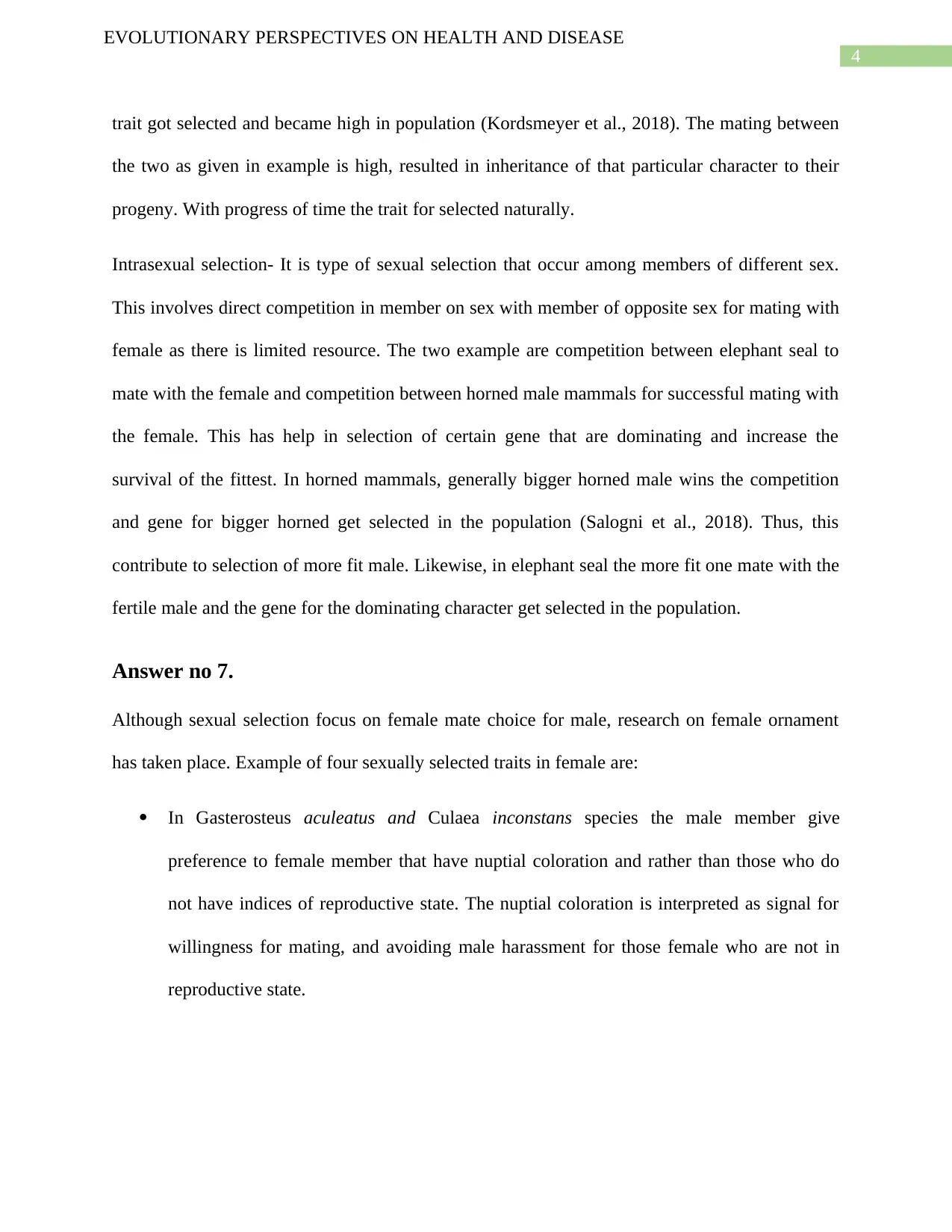
4
EVOLUTIONARY PERSPECTIVES ON HEALTH AND DISEASE
trait got selected and became high in population (Kordsmeyer et al., 2018). The mating between
the two as given in example is high, resulted in inheritance of that particular character to their
progeny. With progress of time the trait for selected naturally.
Intrasexual selection- It is type of sexual selection that occur among members of different sex.
This involves direct competition in member on sex with member of opposite sex for mating with
female as there is limited resource. The two example are competition between elephant seal to
mate with the female and competition between horned male mammals for successful mating with
the female. This has help in selection of certain gene that are dominating and increase the
survival of the fittest. In horned mammals, generally bigger horned male wins the competition
and gene for bigger horned get selected in the population (Salogni et al., 2018). Thus, this
contribute to selection of more fit male. Likewise, in elephant seal the more fit one mate with the
fertile male and the gene for the dominating character get selected in the population.
Answer no 7.
Although sexual selection focus on female mate choice for male, research on female ornament
has taken place. Example of four sexually selected traits in female are:
In Gasterosteus aculeatus and Culaea inconstans species the male member give
preference to female member that have nuptial coloration and rather than those who do
not have indices of reproductive state. The nuptial coloration is interpreted as signal for
willingness for mating, and avoiding male harassment for those female who are not in
reproductive state.
EVOLUTIONARY PERSPECTIVES ON HEALTH AND DISEASE
trait got selected and became high in population (Kordsmeyer et al., 2018). The mating between
the two as given in example is high, resulted in inheritance of that particular character to their
progeny. With progress of time the trait for selected naturally.
Intrasexual selection- It is type of sexual selection that occur among members of different sex.
This involves direct competition in member on sex with member of opposite sex for mating with
female as there is limited resource. The two example are competition between elephant seal to
mate with the female and competition between horned male mammals for successful mating with
the female. This has help in selection of certain gene that are dominating and increase the
survival of the fittest. In horned mammals, generally bigger horned male wins the competition
and gene for bigger horned get selected in the population (Salogni et al., 2018). Thus, this
contribute to selection of more fit male. Likewise, in elephant seal the more fit one mate with the
fertile male and the gene for the dominating character get selected in the population.
Answer no 7.
Although sexual selection focus on female mate choice for male, research on female ornament
has taken place. Example of four sexually selected traits in female are:
In Gasterosteus aculeatus and Culaea inconstans species the male member give
preference to female member that have nuptial coloration and rather than those who do
not have indices of reproductive state. The nuptial coloration is interpreted as signal for
willingness for mating, and avoiding male harassment for those female who are not in
reproductive state.
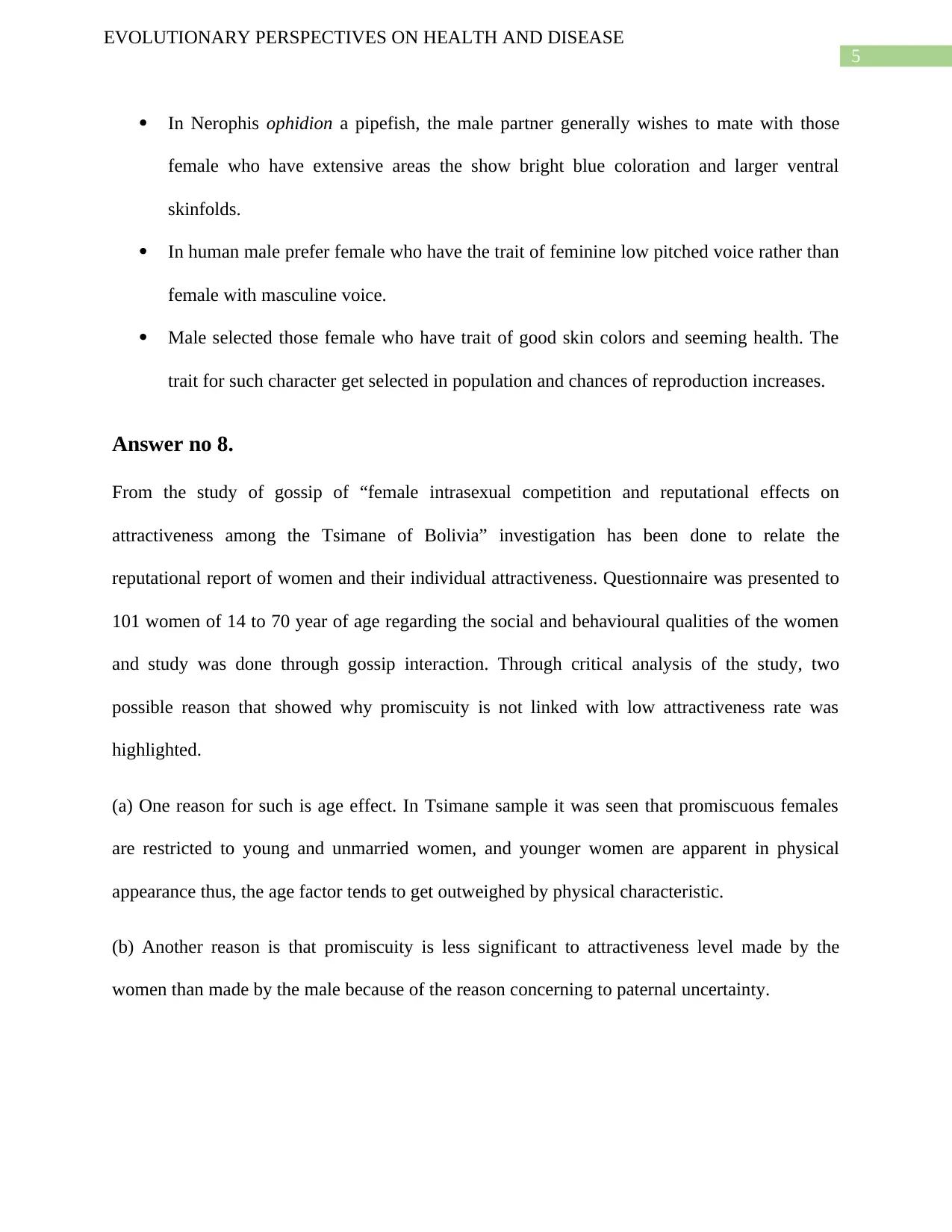
5
EVOLUTIONARY PERSPECTIVES ON HEALTH AND DISEASE
In Nerophis ophidion a pipefish, the male partner generally wishes to mate with those
female who have extensive areas the show bright blue coloration and larger ventral
skinfolds.
In human male prefer female who have the trait of feminine low pitched voice rather than
female with masculine voice.
Male selected those female who have trait of good skin colors and seeming health. The
trait for such character get selected in population and chances of reproduction increases.
Answer no 8.
From the study of gossip of “female intrasexual competition and reputational effects on
attractiveness among the Tsimane of Bolivia” investigation has been done to relate the
reputational report of women and their individual attractiveness. Questionnaire was presented to
101 women of 14 to 70 year of age regarding the social and behavioural qualities of the women
and study was done through gossip interaction. Through critical analysis of the study, two
possible reason that showed why promiscuity is not linked with low attractiveness rate was
highlighted.
(a) One reason for such is age effect. In Tsimane sample it was seen that promiscuous females
are restricted to young and unmarried women, and younger women are apparent in physical
appearance thus, the age factor tends to get outweighed by physical characteristic.
(b) Another reason is that promiscuity is less significant to attractiveness level made by the
women than made by the male because of the reason concerning to paternal uncertainty.
EVOLUTIONARY PERSPECTIVES ON HEALTH AND DISEASE
In Nerophis ophidion a pipefish, the male partner generally wishes to mate with those
female who have extensive areas the show bright blue coloration and larger ventral
skinfolds.
In human male prefer female who have the trait of feminine low pitched voice rather than
female with masculine voice.
Male selected those female who have trait of good skin colors and seeming health. The
trait for such character get selected in population and chances of reproduction increases.
Answer no 8.
From the study of gossip of “female intrasexual competition and reputational effects on
attractiveness among the Tsimane of Bolivia” investigation has been done to relate the
reputational report of women and their individual attractiveness. Questionnaire was presented to
101 women of 14 to 70 year of age regarding the social and behavioural qualities of the women
and study was done through gossip interaction. Through critical analysis of the study, two
possible reason that showed why promiscuity is not linked with low attractiveness rate was
highlighted.
(a) One reason for such is age effect. In Tsimane sample it was seen that promiscuous females
are restricted to young and unmarried women, and younger women are apparent in physical
appearance thus, the age factor tends to get outweighed by physical characteristic.
(b) Another reason is that promiscuity is less significant to attractiveness level made by the
women than made by the male because of the reason concerning to paternal uncertainty.
⊘ This is a preview!⊘
Do you want full access?
Subscribe today to unlock all pages.

Trusted by 1+ million students worldwide
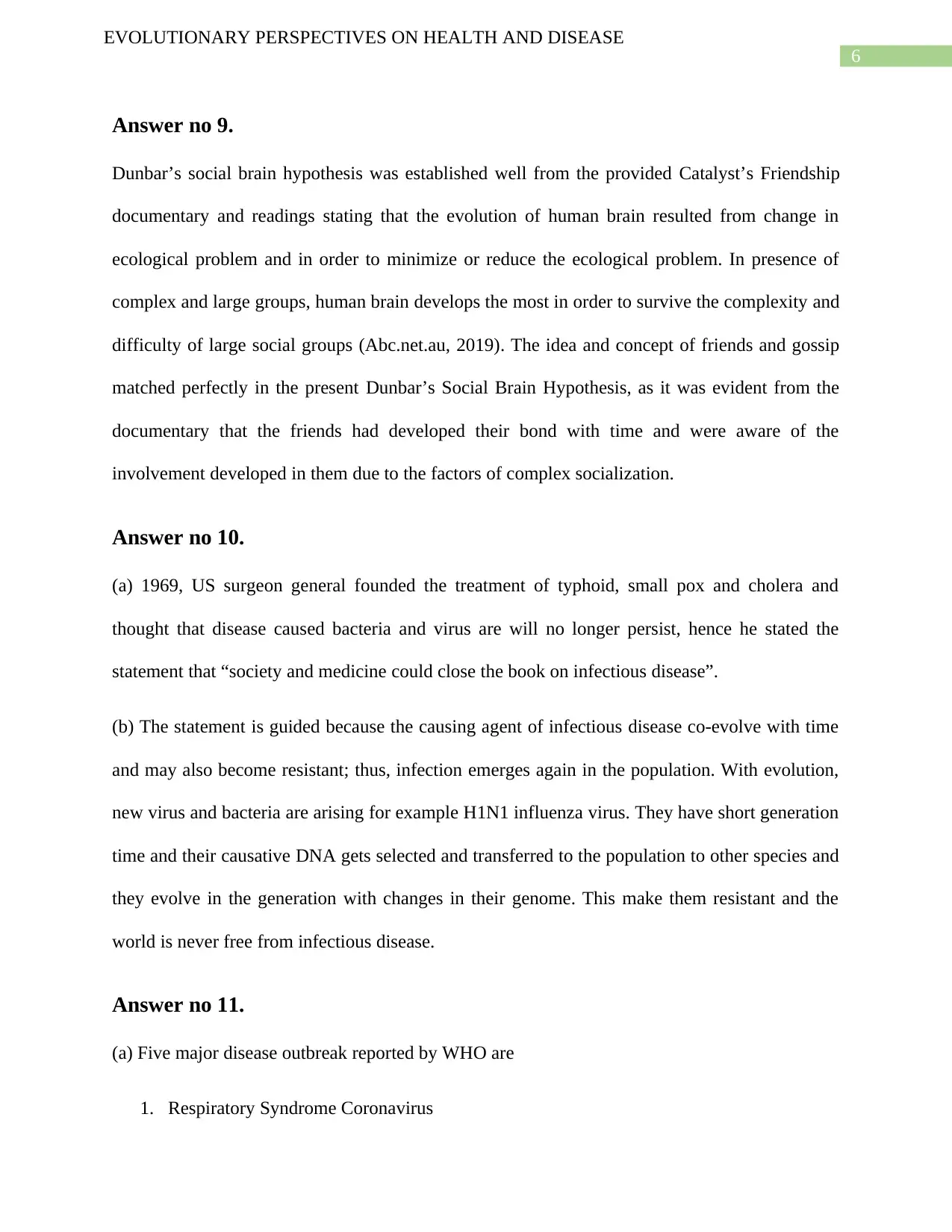
6
EVOLUTIONARY PERSPECTIVES ON HEALTH AND DISEASE
Answer no 9.
Dunbar’s social brain hypothesis was established well from the provided Catalyst’s Friendship
documentary and readings stating that the evolution of human brain resulted from change in
ecological problem and in order to minimize or reduce the ecological problem. In presence of
complex and large groups, human brain develops the most in order to survive the complexity and
difficulty of large social groups (Abc.net.au, 2019). The idea and concept of friends and gossip
matched perfectly in the present Dunbar’s Social Brain Hypothesis, as it was evident from the
documentary that the friends had developed their bond with time and were aware of the
involvement developed in them due to the factors of complex socialization.
Answer no 10.
(a) 1969, US surgeon general founded the treatment of typhoid, small pox and cholera and
thought that disease caused bacteria and virus are will no longer persist, hence he stated the
statement that “society and medicine could close the book on infectious disease”.
(b) The statement is guided because the causing agent of infectious disease co-evolve with time
and may also become resistant; thus, infection emerges again in the population. With evolution,
new virus and bacteria are arising for example H1N1 influenza virus. They have short generation
time and their causative DNA gets selected and transferred to the population to other species and
they evolve in the generation with changes in their genome. This make them resistant and the
world is never free from infectious disease.
Answer no 11.
(a) Five major disease outbreak reported by WHO are
1. Respiratory Syndrome Coronavirus
EVOLUTIONARY PERSPECTIVES ON HEALTH AND DISEASE
Answer no 9.
Dunbar’s social brain hypothesis was established well from the provided Catalyst’s Friendship
documentary and readings stating that the evolution of human brain resulted from change in
ecological problem and in order to minimize or reduce the ecological problem. In presence of
complex and large groups, human brain develops the most in order to survive the complexity and
difficulty of large social groups (Abc.net.au, 2019). The idea and concept of friends and gossip
matched perfectly in the present Dunbar’s Social Brain Hypothesis, as it was evident from the
documentary that the friends had developed their bond with time and were aware of the
involvement developed in them due to the factors of complex socialization.
Answer no 10.
(a) 1969, US surgeon general founded the treatment of typhoid, small pox and cholera and
thought that disease caused bacteria and virus are will no longer persist, hence he stated the
statement that “society and medicine could close the book on infectious disease”.
(b) The statement is guided because the causing agent of infectious disease co-evolve with time
and may also become resistant; thus, infection emerges again in the population. With evolution,
new virus and bacteria are arising for example H1N1 influenza virus. They have short generation
time and their causative DNA gets selected and transferred to the population to other species and
they evolve in the generation with changes in their genome. This make them resistant and the
world is never free from infectious disease.
Answer no 11.
(a) Five major disease outbreak reported by WHO are
1. Respiratory Syndrome Coronavirus
Paraphrase This Document
Need a fresh take? Get an instant paraphrase of this document with our AI Paraphraser
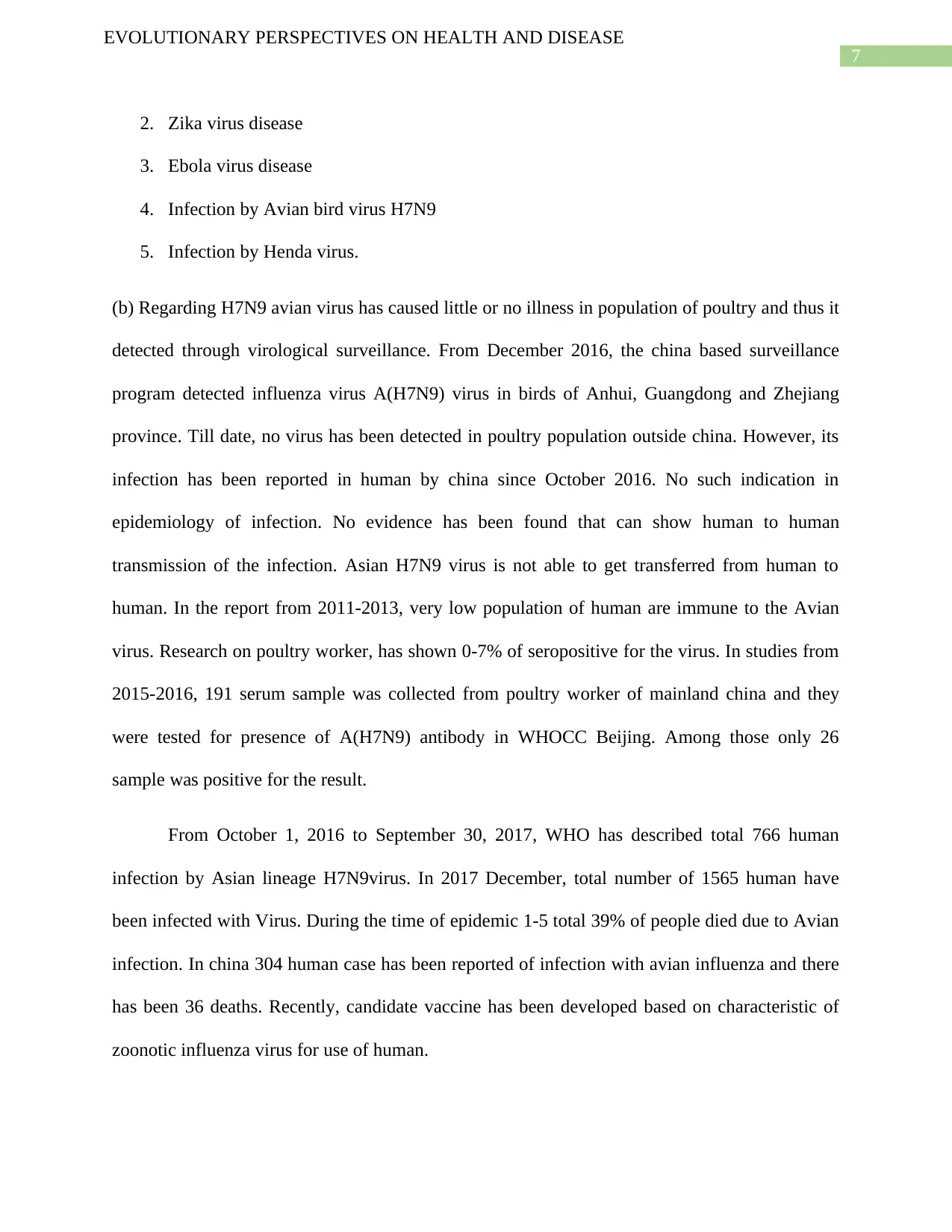
7
EVOLUTIONARY PERSPECTIVES ON HEALTH AND DISEASE
2. Zika virus disease
3. Ebola virus disease
4. Infection by Avian bird virus H7N9
5. Infection by Henda virus.
(b) Regarding H7N9 avian virus has caused little or no illness in population of poultry and thus it
detected through virological surveillance. From December 2016, the china based surveillance
program detected influenza virus A(H7N9) virus in birds of Anhui, Guangdong and Zhejiang
province. Till date, no virus has been detected in poultry population outside china. However, its
infection has been reported in human by china since October 2016. No such indication in
epidemiology of infection. No evidence has been found that can show human to human
transmission of the infection. Asian H7N9 virus is not able to get transferred from human to
human. In the report from 2011-2013, very low population of human are immune to the Avian
virus. Research on poultry worker, has shown 0-7% of seropositive for the virus. In studies from
2015-2016, 191 serum sample was collected from poultry worker of mainland china and they
were tested for presence of A(H7N9) antibody in WHOCC Beijing. Among those only 26
sample was positive for the result.
From October 1, 2016 to September 30, 2017, WHO has described total 766 human
infection by Asian lineage H7N9virus. In 2017 December, total number of 1565 human have
been infected with Virus. During the time of epidemic 1-5 total 39% of people died due to Avian
infection. In china 304 human case has been reported of infection with avian influenza and there
has been 36 deaths. Recently, candidate vaccine has been developed based on characteristic of
zoonotic influenza virus for use of human.
EVOLUTIONARY PERSPECTIVES ON HEALTH AND DISEASE
2. Zika virus disease
3. Ebola virus disease
4. Infection by Avian bird virus H7N9
5. Infection by Henda virus.
(b) Regarding H7N9 avian virus has caused little or no illness in population of poultry and thus it
detected through virological surveillance. From December 2016, the china based surveillance
program detected influenza virus A(H7N9) virus in birds of Anhui, Guangdong and Zhejiang
province. Till date, no virus has been detected in poultry population outside china. However, its
infection has been reported in human by china since October 2016. No such indication in
epidemiology of infection. No evidence has been found that can show human to human
transmission of the infection. Asian H7N9 virus is not able to get transferred from human to
human. In the report from 2011-2013, very low population of human are immune to the Avian
virus. Research on poultry worker, has shown 0-7% of seropositive for the virus. In studies from
2015-2016, 191 serum sample was collected from poultry worker of mainland china and they
were tested for presence of A(H7N9) antibody in WHOCC Beijing. Among those only 26
sample was positive for the result.
From October 1, 2016 to September 30, 2017, WHO has described total 766 human
infection by Asian lineage H7N9virus. In 2017 December, total number of 1565 human have
been infected with Virus. During the time of epidemic 1-5 total 39% of people died due to Avian
infection. In china 304 human case has been reported of infection with avian influenza and there
has been 36 deaths. Recently, candidate vaccine has been developed based on characteristic of
zoonotic influenza virus for use of human.
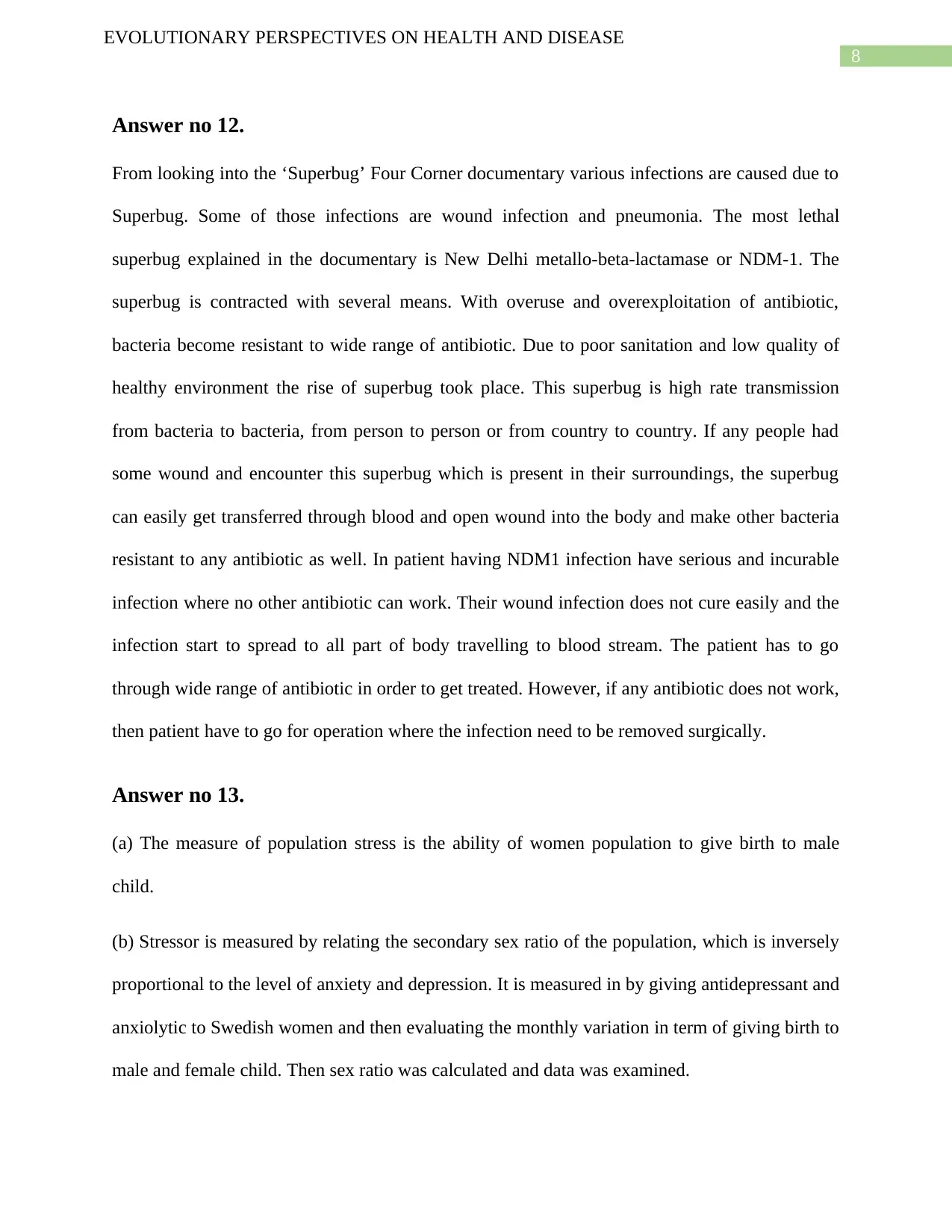
8
EVOLUTIONARY PERSPECTIVES ON HEALTH AND DISEASE
Answer no 12.
From looking into the ‘Superbug’ Four Corner documentary various infections are caused due to
Superbug. Some of those infections are wound infection and pneumonia. The most lethal
superbug explained in the documentary is New Delhi metallo-beta-lactamase or NDM-1. The
superbug is contracted with several means. With overuse and overexploitation of antibiotic,
bacteria become resistant to wide range of antibiotic. Due to poor sanitation and low quality of
healthy environment the rise of superbug took place. This superbug is high rate transmission
from bacteria to bacteria, from person to person or from country to country. If any people had
some wound and encounter this superbug which is present in their surroundings, the superbug
can easily get transferred through blood and open wound into the body and make other bacteria
resistant to any antibiotic as well. In patient having NDM1 infection have serious and incurable
infection where no other antibiotic can work. Their wound infection does not cure easily and the
infection start to spread to all part of body travelling to blood stream. The patient has to go
through wide range of antibiotic in order to get treated. However, if any antibiotic does not work,
then patient have to go for operation where the infection need to be removed surgically.
Answer no 13.
(a) The measure of population stress is the ability of women population to give birth to male
child.
(b) Stressor is measured by relating the secondary sex ratio of the population, which is inversely
proportional to the level of anxiety and depression. It is measured in by giving antidepressant and
anxiolytic to Swedish women and then evaluating the monthly variation in term of giving birth to
male and female child. Then sex ratio was calculated and data was examined.
EVOLUTIONARY PERSPECTIVES ON HEALTH AND DISEASE
Answer no 12.
From looking into the ‘Superbug’ Four Corner documentary various infections are caused due to
Superbug. Some of those infections are wound infection and pneumonia. The most lethal
superbug explained in the documentary is New Delhi metallo-beta-lactamase or NDM-1. The
superbug is contracted with several means. With overuse and overexploitation of antibiotic,
bacteria become resistant to wide range of antibiotic. Due to poor sanitation and low quality of
healthy environment the rise of superbug took place. This superbug is high rate transmission
from bacteria to bacteria, from person to person or from country to country. If any people had
some wound and encounter this superbug which is present in their surroundings, the superbug
can easily get transferred through blood and open wound into the body and make other bacteria
resistant to any antibiotic as well. In patient having NDM1 infection have serious and incurable
infection where no other antibiotic can work. Their wound infection does not cure easily and the
infection start to spread to all part of body travelling to blood stream. The patient has to go
through wide range of antibiotic in order to get treated. However, if any antibiotic does not work,
then patient have to go for operation where the infection need to be removed surgically.
Answer no 13.
(a) The measure of population stress is the ability of women population to give birth to male
child.
(b) Stressor is measured by relating the secondary sex ratio of the population, which is inversely
proportional to the level of anxiety and depression. It is measured in by giving antidepressant and
anxiolytic to Swedish women and then evaluating the monthly variation in term of giving birth to
male and female child. Then sex ratio was calculated and data was examined.
⊘ This is a preview!⊘
Do you want full access?
Subscribe today to unlock all pages.

Trusted by 1+ million students worldwide
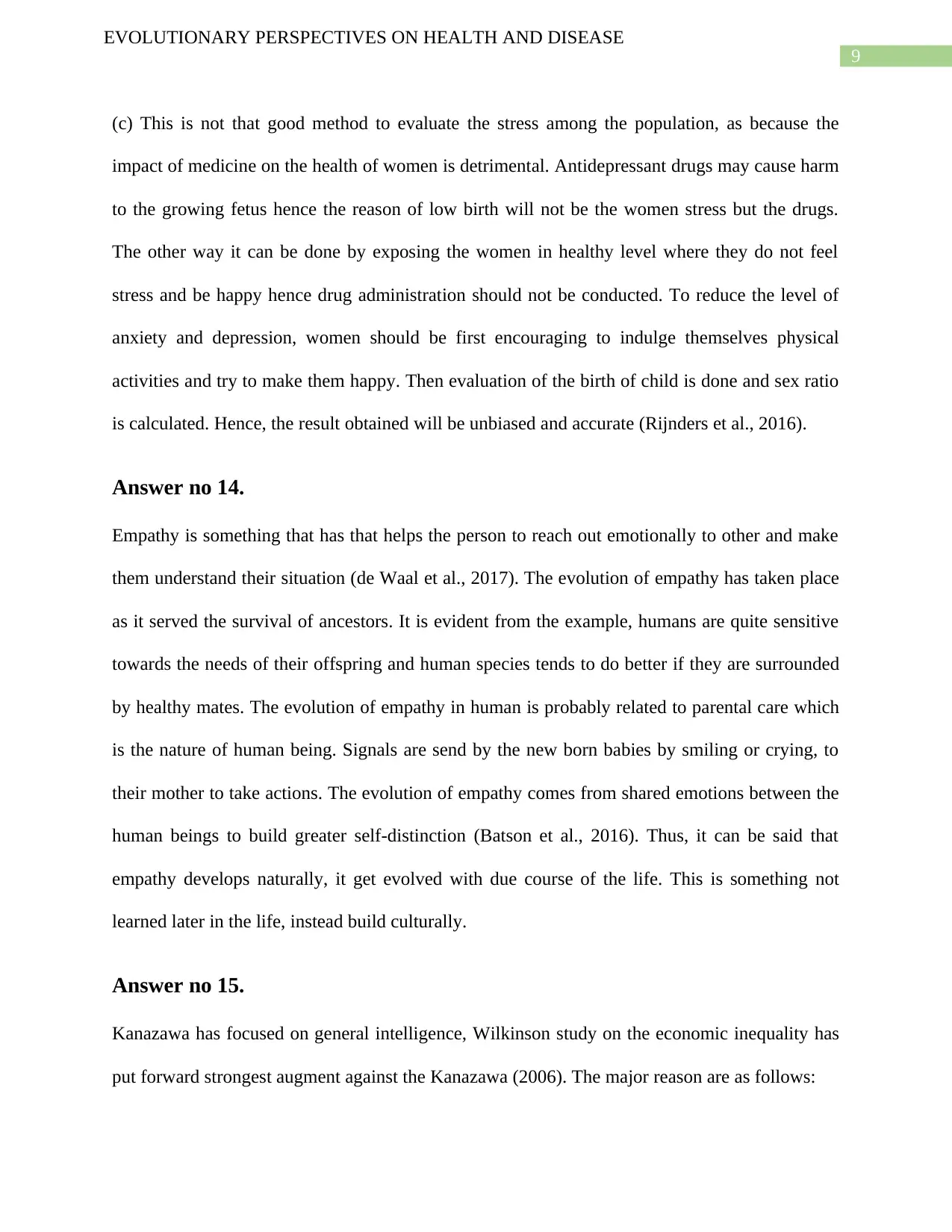
9
EVOLUTIONARY PERSPECTIVES ON HEALTH AND DISEASE
(c) This is not that good method to evaluate the stress among the population, as because the
impact of medicine on the health of women is detrimental. Antidepressant drugs may cause harm
to the growing fetus hence the reason of low birth will not be the women stress but the drugs.
The other way it can be done by exposing the women in healthy level where they do not feel
stress and be happy hence drug administration should not be conducted. To reduce the level of
anxiety and depression, women should be first encouraging to indulge themselves physical
activities and try to make them happy. Then evaluation of the birth of child is done and sex ratio
is calculated. Hence, the result obtained will be unbiased and accurate (Rijnders et al., 2016).
Answer no 14.
Empathy is something that has that helps the person to reach out emotionally to other and make
them understand their situation (de Waal et al., 2017). The evolution of empathy has taken place
as it served the survival of ancestors. It is evident from the example, humans are quite sensitive
towards the needs of their offspring and human species tends to do better if they are surrounded
by healthy mates. The evolution of empathy in human is probably related to parental care which
is the nature of human being. Signals are send by the new born babies by smiling or crying, to
their mother to take actions. The evolution of empathy comes from shared emotions between the
human beings to build greater self-distinction (Batson et al., 2016). Thus, it can be said that
empathy develops naturally, it get evolved with due course of the life. This is something not
learned later in the life, instead build culturally.
Answer no 15.
Kanazawa has focused on general intelligence, Wilkinson study on the economic inequality has
put forward strongest augment against the Kanazawa (2006). The major reason are as follows:
EVOLUTIONARY PERSPECTIVES ON HEALTH AND DISEASE
(c) This is not that good method to evaluate the stress among the population, as because the
impact of medicine on the health of women is detrimental. Antidepressant drugs may cause harm
to the growing fetus hence the reason of low birth will not be the women stress but the drugs.
The other way it can be done by exposing the women in healthy level where they do not feel
stress and be happy hence drug administration should not be conducted. To reduce the level of
anxiety and depression, women should be first encouraging to indulge themselves physical
activities and try to make them happy. Then evaluation of the birth of child is done and sex ratio
is calculated. Hence, the result obtained will be unbiased and accurate (Rijnders et al., 2016).
Answer no 14.
Empathy is something that has that helps the person to reach out emotionally to other and make
them understand their situation (de Waal et al., 2017). The evolution of empathy has taken place
as it served the survival of ancestors. It is evident from the example, humans are quite sensitive
towards the needs of their offspring and human species tends to do better if they are surrounded
by healthy mates. The evolution of empathy in human is probably related to parental care which
is the nature of human being. Signals are send by the new born babies by smiling or crying, to
their mother to take actions. The evolution of empathy comes from shared emotions between the
human beings to build greater self-distinction (Batson et al., 2016). Thus, it can be said that
empathy develops naturally, it get evolved with due course of the life. This is something not
learned later in the life, instead build culturally.
Answer no 15.
Kanazawa has focused on general intelligence, Wilkinson study on the economic inequality has
put forward strongest augment against the Kanazawa (2006). The major reason are as follows:
Paraphrase This Document
Need a fresh take? Get an instant paraphrase of this document with our AI Paraphraser
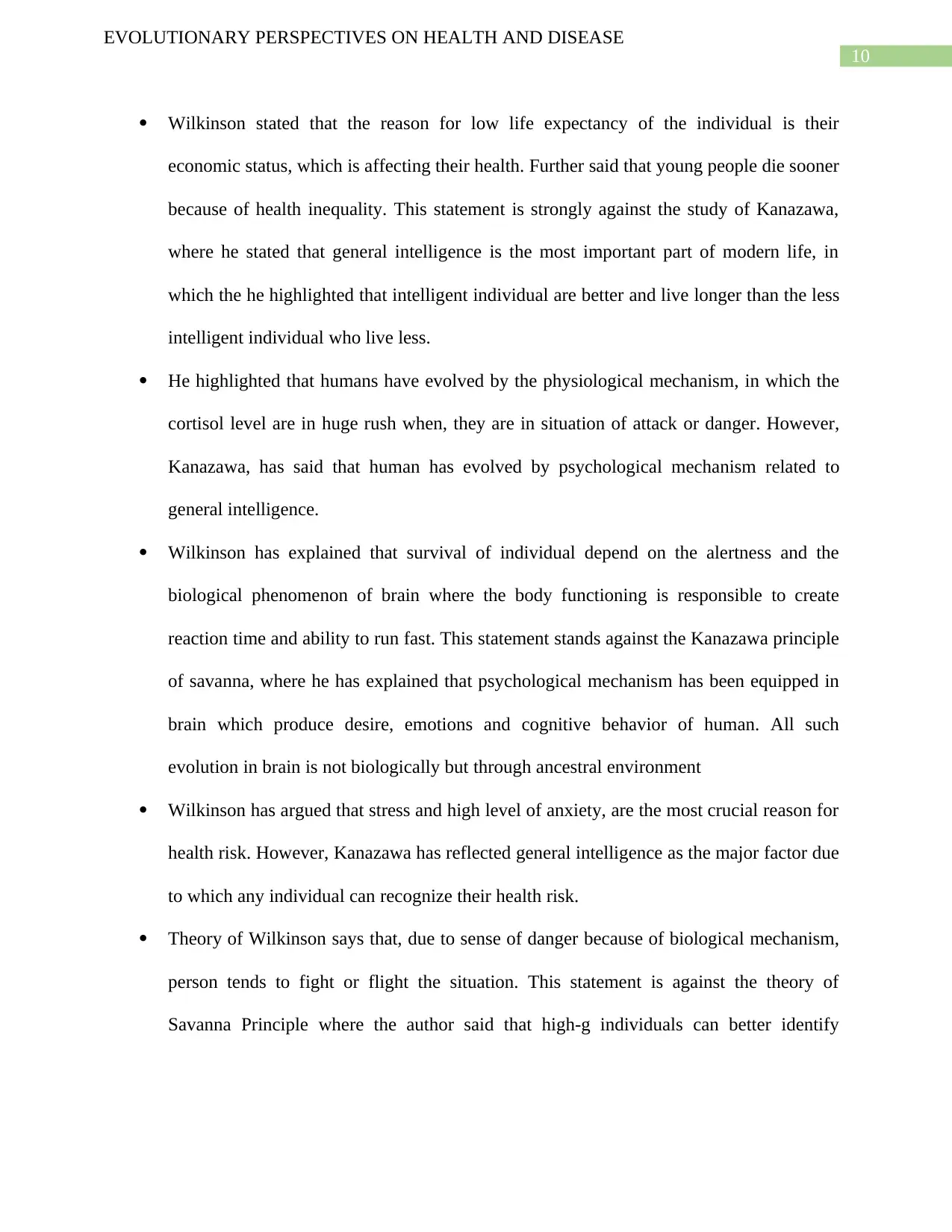
10
EVOLUTIONARY PERSPECTIVES ON HEALTH AND DISEASE
Wilkinson stated that the reason for low life expectancy of the individual is their
economic status, which is affecting their health. Further said that young people die sooner
because of health inequality. This statement is strongly against the study of Kanazawa,
where he stated that general intelligence is the most important part of modern life, in
which the he highlighted that intelligent individual are better and live longer than the less
intelligent individual who live less.
He highlighted that humans have evolved by the physiological mechanism, in which the
cortisol level are in huge rush when, they are in situation of attack or danger. However,
Kanazawa, has said that human has evolved by psychological mechanism related to
general intelligence.
Wilkinson has explained that survival of individual depend on the alertness and the
biological phenomenon of brain where the body functioning is responsible to create
reaction time and ability to run fast. This statement stands against the Kanazawa principle
of savanna, where he has explained that psychological mechanism has been equipped in
brain which produce desire, emotions and cognitive behavior of human. All such
evolution in brain is not biologically but through ancestral environment
Wilkinson has argued that stress and high level of anxiety, are the most crucial reason for
health risk. However, Kanazawa has reflected general intelligence as the major factor due
to which any individual can recognize their health risk.
Theory of Wilkinson says that, due to sense of danger because of biological mechanism,
person tends to fight or flight the situation. This statement is against the theory of
Savanna Principle where the author said that high-g individuals can better identify
EVOLUTIONARY PERSPECTIVES ON HEALTH AND DISEASE
Wilkinson stated that the reason for low life expectancy of the individual is their
economic status, which is affecting their health. Further said that young people die sooner
because of health inequality. This statement is strongly against the study of Kanazawa,
where he stated that general intelligence is the most important part of modern life, in
which the he highlighted that intelligent individual are better and live longer than the less
intelligent individual who live less.
He highlighted that humans have evolved by the physiological mechanism, in which the
cortisol level are in huge rush when, they are in situation of attack or danger. However,
Kanazawa, has said that human has evolved by psychological mechanism related to
general intelligence.
Wilkinson has explained that survival of individual depend on the alertness and the
biological phenomenon of brain where the body functioning is responsible to create
reaction time and ability to run fast. This statement stands against the Kanazawa principle
of savanna, where he has explained that psychological mechanism has been equipped in
brain which produce desire, emotions and cognitive behavior of human. All such
evolution in brain is not biologically but through ancestral environment
Wilkinson has argued that stress and high level of anxiety, are the most crucial reason for
health risk. However, Kanazawa has reflected general intelligence as the major factor due
to which any individual can recognize their health risk.
Theory of Wilkinson says that, due to sense of danger because of biological mechanism,
person tends to fight or flight the situation. This statement is against the theory of
Savanna Principle where the author said that high-g individuals can better identify
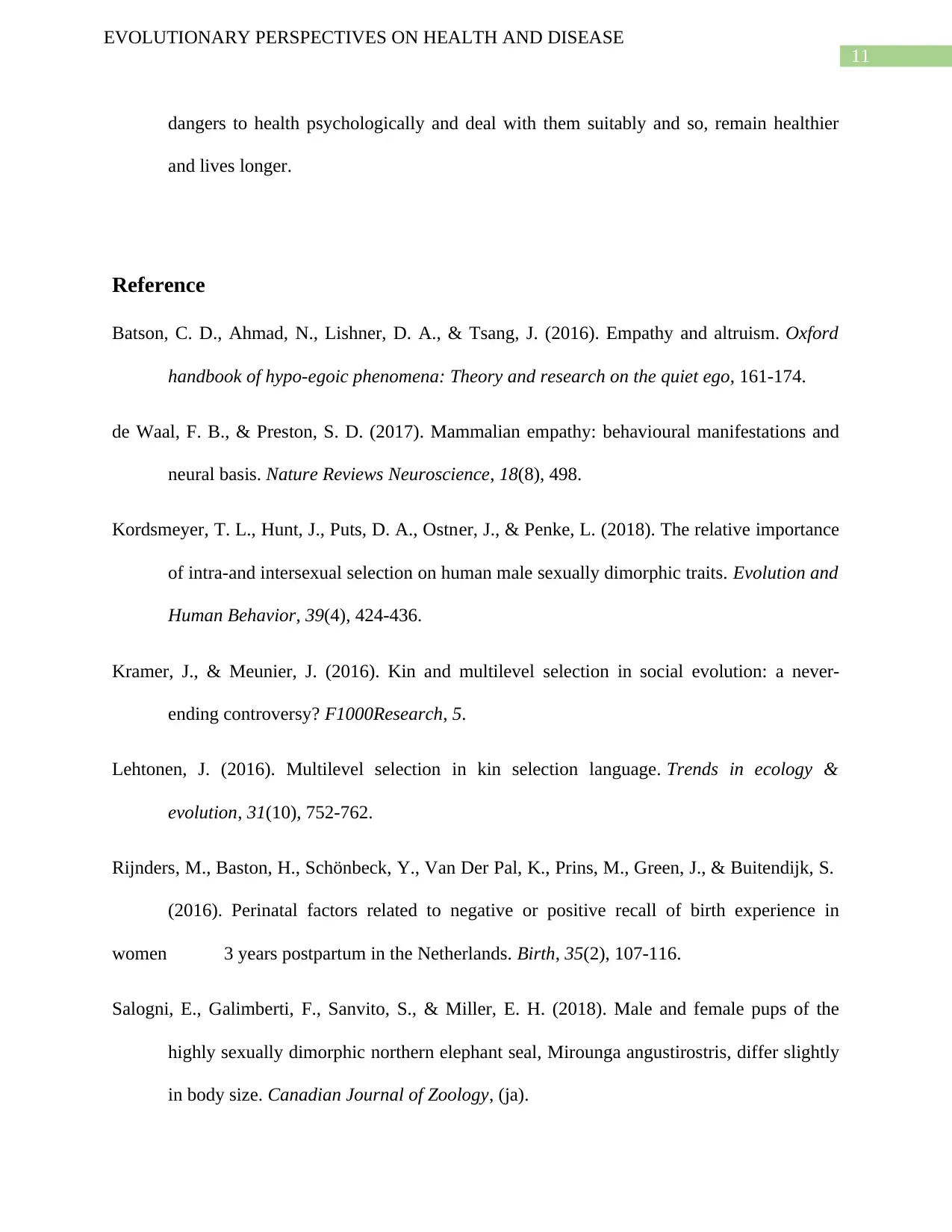
11
EVOLUTIONARY PERSPECTIVES ON HEALTH AND DISEASE
dangers to health psychologically and deal with them suitably and so, remain healthier
and lives longer.
Reference
Batson, C. D., Ahmad, N., Lishner, D. A., & Tsang, J. (2016). Empathy and altruism. Oxford
handbook of hypo-egoic phenomena: Theory and research on the quiet ego, 161-174.
de Waal, F. B., & Preston, S. D. (2017). Mammalian empathy: behavioural manifestations and
neural basis. Nature Reviews Neuroscience, 18(8), 498.
Kordsmeyer, T. L., Hunt, J., Puts, D. A., Ostner, J., & Penke, L. (2018). The relative importance
of intra-and intersexual selection on human male sexually dimorphic traits. Evolution and
Human Behavior, 39(4), 424-436.
Kramer, J., & Meunier, J. (2016). Kin and multilevel selection in social evolution: a never-
ending controversy? F1000Research, 5.
Lehtonen, J. (2016). Multilevel selection in kin selection language. Trends in ecology &
evolution, 31(10), 752-762.
Rijnders, M., Baston, H., Schönbeck, Y., Van Der Pal, K., Prins, M., Green, J., & Buitendijk, S.
(2016). Perinatal factors related to negative or positive recall of birth experience in
women 3 years postpartum in the Netherlands. Birth, 35(2), 107-116.
Salogni, E., Galimberti, F., Sanvito, S., & Miller, E. H. (2018). Male and female pups of the
highly sexually dimorphic northern elephant seal, Mirounga angustirostris, differ slightly
in body size. Canadian Journal of Zoology, (ja).
EVOLUTIONARY PERSPECTIVES ON HEALTH AND DISEASE
dangers to health psychologically and deal with them suitably and so, remain healthier
and lives longer.
Reference
Batson, C. D., Ahmad, N., Lishner, D. A., & Tsang, J. (2016). Empathy and altruism. Oxford
handbook of hypo-egoic phenomena: Theory and research on the quiet ego, 161-174.
de Waal, F. B., & Preston, S. D. (2017). Mammalian empathy: behavioural manifestations and
neural basis. Nature Reviews Neuroscience, 18(8), 498.
Kordsmeyer, T. L., Hunt, J., Puts, D. A., Ostner, J., & Penke, L. (2018). The relative importance
of intra-and intersexual selection on human male sexually dimorphic traits. Evolution and
Human Behavior, 39(4), 424-436.
Kramer, J., & Meunier, J. (2016). Kin and multilevel selection in social evolution: a never-
ending controversy? F1000Research, 5.
Lehtonen, J. (2016). Multilevel selection in kin selection language. Trends in ecology &
evolution, 31(10), 752-762.
Rijnders, M., Baston, H., Schönbeck, Y., Van Der Pal, K., Prins, M., Green, J., & Buitendijk, S.
(2016). Perinatal factors related to negative or positive recall of birth experience in
women 3 years postpartum in the Netherlands. Birth, 35(2), 107-116.
Salogni, E., Galimberti, F., Sanvito, S., & Miller, E. H. (2018). Male and female pups of the
highly sexually dimorphic northern elephant seal, Mirounga angustirostris, differ slightly
in body size. Canadian Journal of Zoology, (ja).
⊘ This is a preview!⊘
Do you want full access?
Subscribe today to unlock all pages.

Trusted by 1+ million students worldwide
1 out of 13
Related Documents
Your All-in-One AI-Powered Toolkit for Academic Success.
+13062052269
info@desklib.com
Available 24*7 on WhatsApp / Email
![[object Object]](/_next/static/media/star-bottom.7253800d.svg)
Unlock your academic potential
Copyright © 2020–2025 A2Z Services. All Rights Reserved. Developed and managed by ZUCOL.





